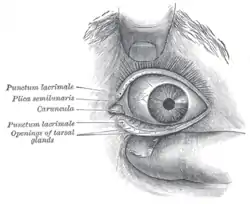Plica semilunaris of conjunctiva
The plica semilunaris is a small fold of bulbar conjunctiva on the medial canthus of the eye. It functions during movement of the eye, to help maintain tear drainage via the lacrimal lake, and to permit greater rotation of the globe, for without the plica the conjunctiva would attach directly to the eyeball, restricting movement.[1] It is the vestigial remnant of the nictitating membrane (the "third eyelid") which is drawn across the eye for protection, and is present in other animals such as birds, reptiles, and fish, but is rare in mammals, mainly found in monotremes and marsupials.[2] Its associated muscles are also vestigial.[3] It is loose, thus eye movements are not restricted by it. Only one species of primate, the Calabar angwantibo, is known to have a functioning nictitating membrane.[4]
| Plica semilunaris of the conjunctiva | |
|---|---|
 Front of left eye with eyelids separated to show medial canthus. (Plica semilunaris labeled at center left.) | |
| Details | |
| Identifiers | |
| Latin | plica semilunaris conjunctivae |
| TA98 | A15.2.07.048 |
| TA2 | 6841 |
| FMA | 59045 |
| Anatomical terminology | |
With ocular allergies, the lacrimal caruncle and plica semilunaris may be inflamed and pruritic (itchy) due to histamine release in the tissue and tear film.
References
- Dartt DA (2006). "The Conjunctiva—Structure and Function". Duane's Foundations of Clinical Ophthalmology. Vol. 2. Philadelphia: Lippincott Williams & Wilkins. Chapter 2. Archived from the original on June 16, 2017. Retrieved November 8, 2012.
- Owen R (1866–1868). Comparative Anatomy and Physiology of Vertebrates. London.
- Darwin C (1871). The Descent of Man, and Selection in Relation to Sex. London: John Murray.
- Montagna W, Machida H, Perkins EM (November 1966). "The skin of primates. 33. The skin of the Angwantibo (Arctocebus calabarensis)". American Journal of Physical Anthropology. 25 (3): 277–90. doi:10.1002/ajpa.1330250307. PMID 5971502.